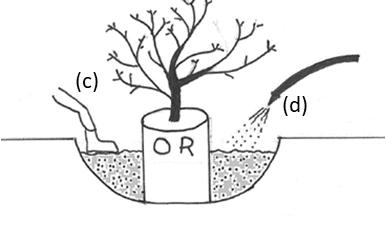protect your pond
To download a printer-friendly version of this brochure, click here.

Lake water quality is best protected with five layers of buffer vegetation at least 10’ deep along the shoreline. The best native buffer plants:
- Are hardy and beautiful in many seasons.
- Are widely available at local nurseries.
- Tolerate a range of soils and sun conditions.
- Grow rapidly, with spreading root systems.
- May attract pollinators and wildlife.
General planting guide



- Choose plants suitable for your location.
- Dig the hole 2-3 times the width of the container/root ball.
- Set the plant on undisturbed soil (a) so top is 1”-2” higher than the surrounding grade (b).
- If the plant is root bound, cut vertical slices through the circling roots.
- Do not add compost, manure or other amendments unless the soil is very poor, then up to 25% may be added.
- Backfill with half of the native soil. To eliminate air pockets, tamp lightly (c) OR flood with water then let drain (d).
- Complete filling hole to top of root ball. Tamp lightly. Build a shallow water ring around the base of the plant to retain water (e).
- Mulch with 2”-3” shredded bark mulch (f). Leave 2”- 6” bare around stem (g).
- Water regularly (about once a week) and deeply (run hose at a slow trickle). Keeping soil moist but not soggy is the greatest key to success.
- Do not fertilize the first year.
a lakesmart buffer
- Slows and absorbs rain and stormwater.
- Has five layers of vegetation: canopy, midstory, shrubs, ground cover, and duff/mulch.
- Is at least 10’ deep, deeper with increasing slope.
- Has minimum narrow access points to the water showing no signs of erosion.
- Has curving paths that are permeable (i.e., not paved)
For a free LakeSmart evaluation of your shoreline property, please contact lakesmart@lakes.me today.
Learn more
- Common Shrubs of Central Maine Shorelines.
- The Buffer Handbook Plant List.
- UMaine Cooperative Extension’s webpage Plants for the Maine Landscape has links to bulletins for the plants listed below and many more. And Gardening to Conserve Maine’s Native Landscape: Plants to Use and Plants to Avoid is a great resource.
- Native Plant Bulletins:
- UNH Cooperative Extension has two very helpful publications: Native Plants for New England Rain Gardens; and Landscaping at the Waters Edge: An Ecological Approach and Manual for New Hampshire Landowners and Landscapers.
- Visit Maine Audubon’s Native Plant Finder to search for native plants by habitat type.
more about planting
Maine Lakes thanks Doug Kavanaugh of the Greater Pushaw Lake Association for researching and writing this information.
